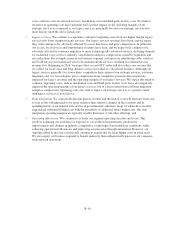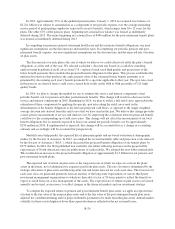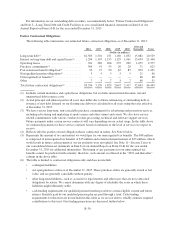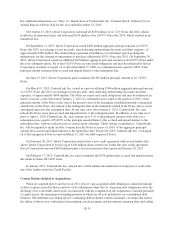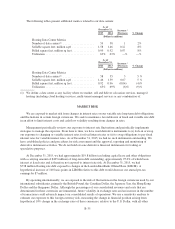CenturyLink 2015 Annual Report Download - page 133
Download and view the complete annual report
Please find page 133 of the 2015 CenturyLink annual report below. You can navigate through the pages in the report by either clicking on the pages listed below, or by using the keyword search tool below to find specific information within the annual report.Changes in any of the above factors could significantly impact operating expenses in the consolidated
statements of operations and other comprehensive income (loss) in the consolidated statements of comprehensive
income (loss) as well as the value of the liability and accumulated other comprehensive loss of stockholders’
equity on our consolidated balance sheets. The expected return on plan assets is reflected as a reduction to our
pension and post-retirement benefit expense. If our assumed expected rates of return for 2015 were 100 basis
points lower, our qualified pension and post-retirement benefit expenses for 2015 would have increased by
$121 million. If our assumed discount rates for 2015 were 100 basis points lower, our qualified pension and post-
retirement benefit expenses for 2015 would have increased by $119 million and our projected benefit obligation
for 2015 would have increased by approximately $1.821 billion.
Loss Contingencies and Litigation Reserves
We are involved in several material legal proceedings, as described in more detail in Note 14—
Commitments and Contingencies to our consolidated financial statements in Item 8 of our Annual Report on
Form 10-K for the year ended December 31, 2015. We assess potential losses in relation to these and other
pending or threatened tax and legal matters. For matters not related to income taxes, if a loss is considered
probable and the amount can be reasonably estimated, we recognize an expense for the estimated loss. To the
extent these estimates are more or less than the actual liability resulting from the resolution of these matters, our
earnings will be increased or decreased accordingly. If the differences are material, our consolidated financial
statements could be materially impacted.
For matters related to income taxes, if we determine in our judgment that the impact of an uncertain tax
position is more likely than not to be sustained upon audit by the relevant taxing authority, then we recognize in
our financial statements a benefit for the largest amount that is more likely than not to be sustained. No portion of
an uncertain tax position will be recognized if we determine in our judgment that the position has less than a 50%
likelihood of being sustained. Though the validity of any tax position is a matter of tax law, the body of statutory,
regulatory and interpretive guidance on the application of the law is complex and often ambiguous. Because of
this, whether a tax position will ultimately be sustained may be uncertain.
Connect America Fund Support Payments
In 2015, we accepted funding from the Connect America Fund (“CAF)” from the Federal Communications
Commission (“FCC”) of approximately $500 million per year for six years to fund the deployment of voice and
high-speed Internet infrastructure for approximately 1.2 million rural households and businesses (living units) in
33 states under the CAF Phase 2 high-cost support program. This program provides a monthly high-cost subsidy
similar to the support provided by the FCC’s previous cost reimbursement programs. Although we believe that
there is no specific authoritative U.S. GAAP guidance for the treatment of government assistance, we identified
three acceptable methods to account for these funds; 1) recognize revenue when entitled to receive cash, 2) defer
cash received until the living units are enabled to receive the service at the FCC specified level, or 3) record the
cash received as contra capital. After assessing these alternatives, we have determined that we will recognize
CAF Phase 2 funds each month as revenue when we are entitled to receive the cash less a deferred amount. The
amount of revenue deferred in 2015 was approximately $12 million. We believe our recognition methodology is
consistent with other companies in our industry in the United States, but may not necessarily be consistent with
companies outside the United States that receive similar government funding, and we cannot provide assurances
to this effect.
In computing the amount of revenue to recognize, we assume that we will not be able to economically
enable 100% of the required living units in every state with voice and high-speed Internet capabilities under the
CAF Phase 2 program. We defer recognition of the funds related to potential living units that we estimate we will
not enable until we can precisely determine that we can fully meet the enablement targets. As disclosed
elsewhere herein, in some limited instances, a portion of the funds must be returned. The effect of a hypothetical
1% change in our estimate of living units we will not enable with voice and high-speed Internet capabilities
B-25



